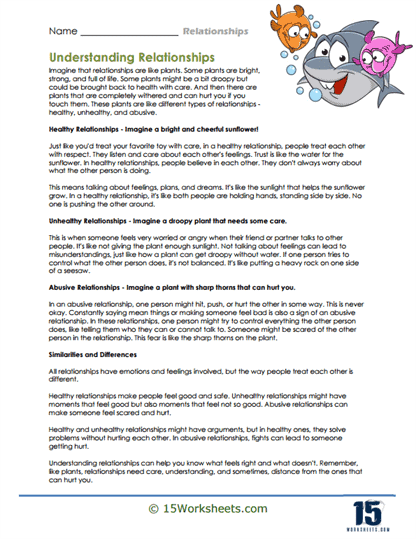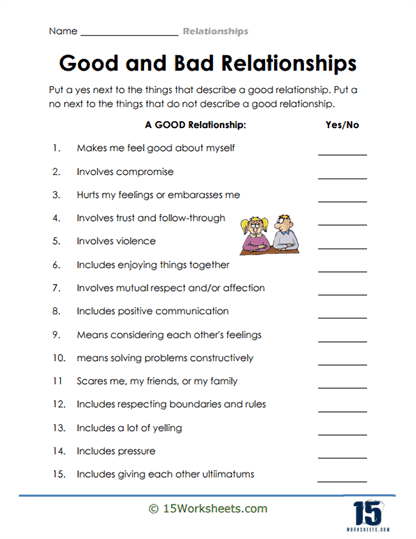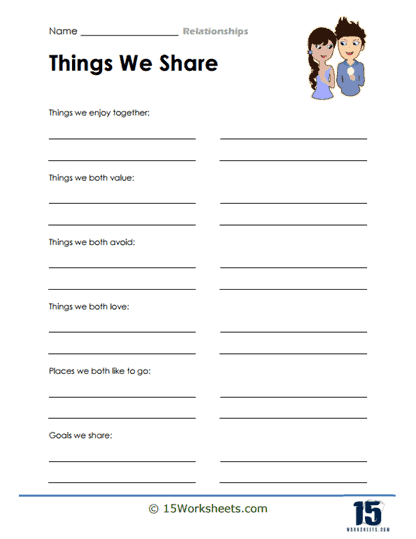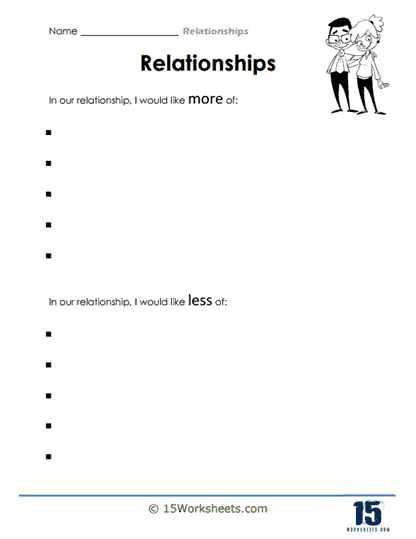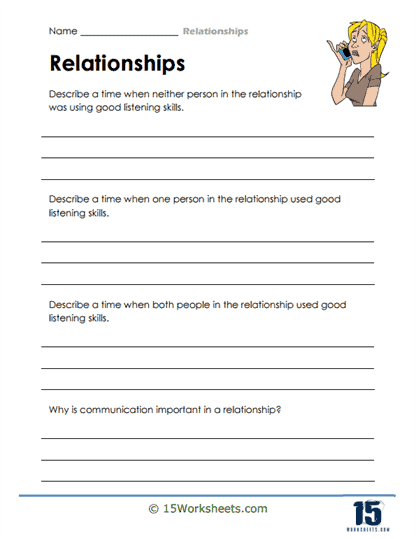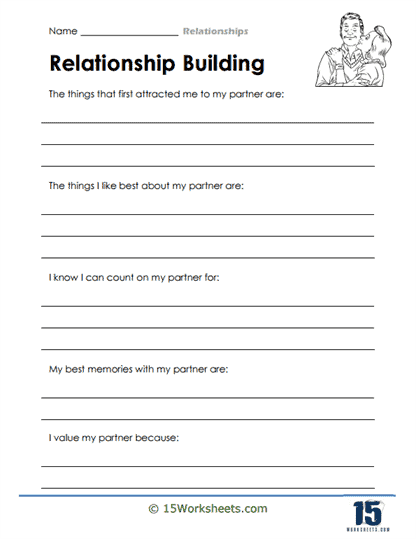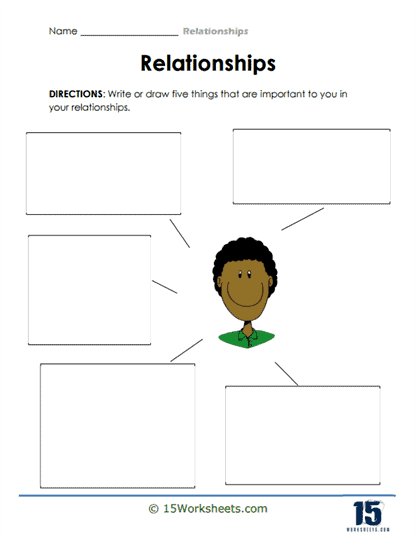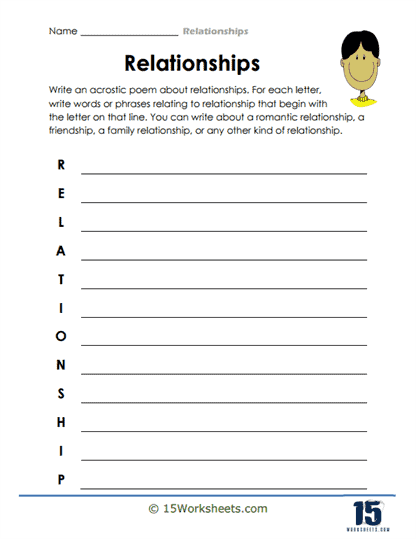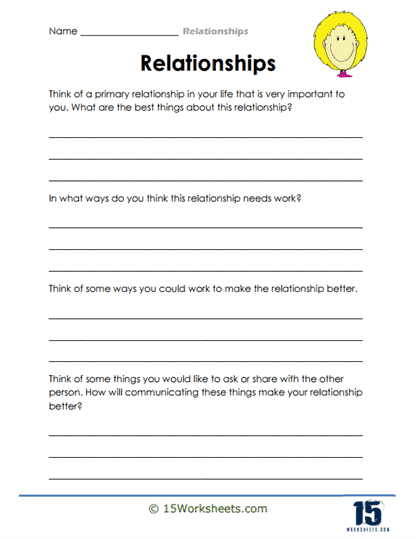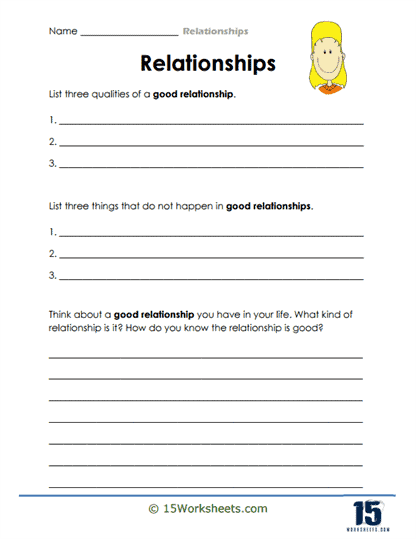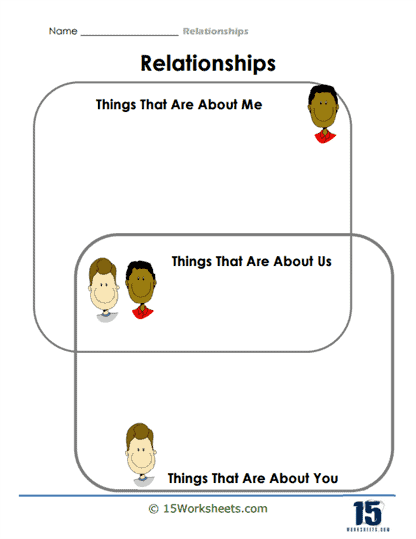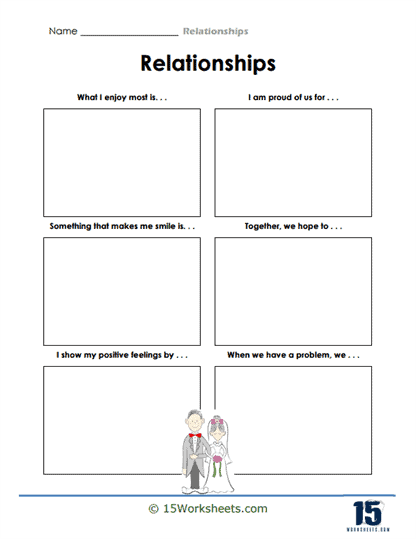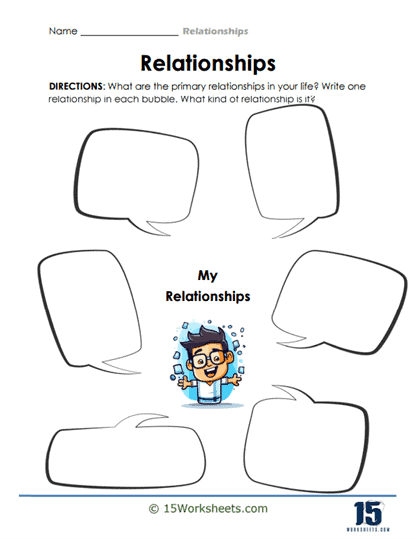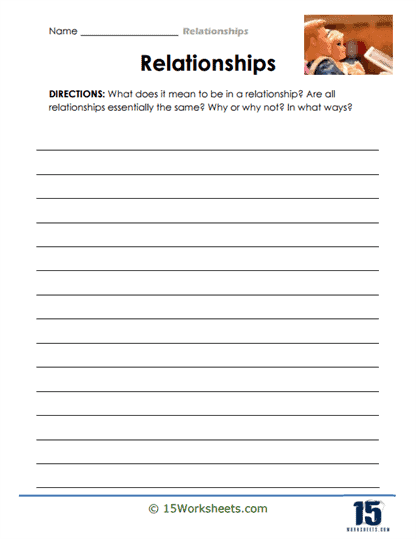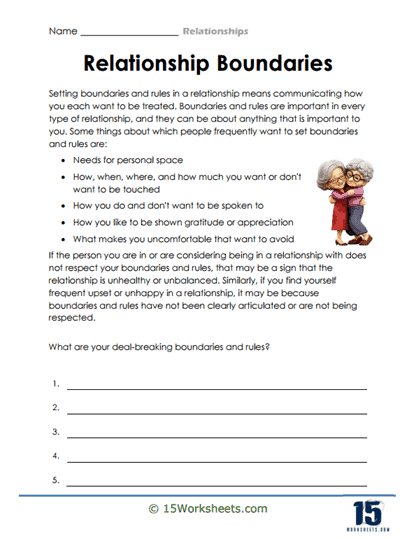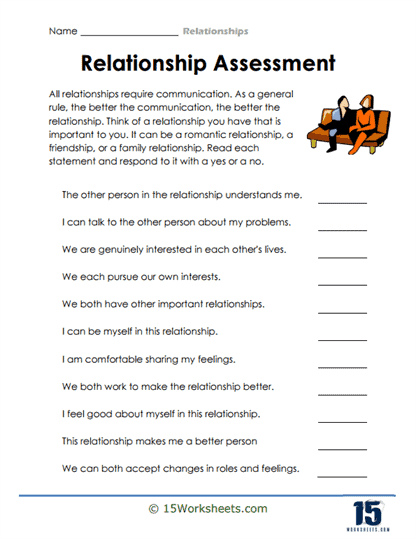Relationships Worksheets
About These 15 Worksheets
The collection of worksheets will help foster understanding and practical skills related to healthy relationships. These materials aim to guide students through various aspects of relationship-building, reflection, communication, and boundary-setting, all of which are critical for personal and emotional growth. Each worksheet contributes uniquely to this process, encouraging students to develop a deeper understanding of what it means to cultivate and maintain healthy, supportive connections. Let’s explore how each set of worksheets works to achieve these goals, and how the skills they promote are essential for young people navigating the complexities of relationships.
Understanding Healthy and Unhealthy Relationships
The first set of worksheets introduces the concept of healthy and unhealthy relationships by using the metaphor of plants. Just as plants need the right conditions-sunlight, water, and care-to thrive, relationships require trust, respect, and communication to grow healthily. Conversely, unhealthy or abusive relationships can be compared to withering plants, deprived of what they need to flourish. This metaphor makes the abstract concept of relationships more tangible, especially for younger audiences. By using clear and relatable examples, these worksheets help students differentiate between relationships that nurture personal growth and those that harm it. In doing so, they not only promote self-awareness but also equip students with the tools to recognize red flags early on. Through this activity, students practice empathy, learning to better understand both their needs and the emotional dynamics in relationships. Additionally, they develop a clearer sense of boundaries, an essential element in maintaining healthy interactions.
Good and Bad Relationships
The worksheet takes a more direct approach, prompting students to identify the characteristics of good and bad relationships by marking “yes” or “no” next to various statements. This simple, straightforward exercise is incredibly effective in engaging students to actively consider what qualities they value in their relationships. Whether it’s trust, respect, or communication, students are encouraged to reflect on how these elements manifest in their own lives. Conversely, the worksheet also addresses negative behaviors, such as violence, coercion, or manipulation. By contrasting positive traits with harmful ones, students gain clarity about what makes relationships functional and fulfilling versus those that are detrimental or even dangerous. This exercise is invaluable in helping young people hone their decision-making skills, allowing them to better assess not only their relationships but also those of their peers. It serves as an early warning system, training students to recognize when a relationship may be heading into harmful territory.
Listening Skills
Listening, often overlooked, is a cornerstone of any healthy relationship, and the third worksheet zeroes in on this vital skill. Students are asked to reflect on scenarios where good or poor listening impacted their relationships, an exercise that brings the significance of active listening into sharp focus. Whether it’s the breakdown of a friendship due to miscommunication or the strengthening of a bond through understanding, students explore how listening can either enhance or strain a relationship. Active listening is not merely about hearing words-it’s about understanding and responding thoughtfully, showing empathy and validation. This worksheet emphasizes the power of communication, reminding students that listening is just as important as speaking in any interaction. The ability to listen effectively not only builds stronger relationships but also enhances self-awareness, as students begin to recognize how their own communication patterns influence those around them.
Self-Reflection
Next, the self-reflection worksheet asks students to take a closer look at a specific, meaningful relationship in their life. By exploring what works well and what needs improvement, students are encouraged to engage in deeper introspection, a process that promotes both self-awareness and emotional intelligence. This exercise moves beyond surface-level observations, encouraging students to think critically about the dynamics at play in their relationships. Are there communication barriers? Is trust consistently upheld? What steps could be taken to improve the relationship? This type of reflective thinking fosters a growth mindset, pushing students to view relationships not as static, but as evolving entities that require effort and intentionality. By practicing problem-solving and constructive communication, students learn that relationships can be nurtured and improved through conscious effort, ultimately leading to more fulfilling connections.
Acrostic Poem
The acrostic poem worksheet introduces a creative twist to the exploration of relationships. Using the word “RELATIONSHIP” as a framework, students are asked to come up with words or phrases that define or describe their understanding of relationships. This exercise is lighthearted yet thought-provoking, allowing students to reflect on relationship qualities in a more personal and creative way. Through this activity, students explore their emotional vocabulary and gain a deeper understanding of what values and qualities they find essential in their interactions with others. The creative nature of this worksheet also offers a welcome break from more structured activities, giving students the freedom to express their thoughts and feelings in a unique format.
Relationship Building
Another critical aspect of relationships is their foundation, and the sixth worksheet focuses on relationship-building, particularly in romantic contexts. Students are asked to reflect on what first attracted them to their partner, what they value most in their relationship, and their fondest memories together. This exercise is not only about reminiscing but about recognizing the positive aspects of a relationship and fostering emotional intelligence. By articulating what makes a relationship meaningful, students are encouraged to practice gratitude and appreciation, both of which are key elements in sustaining long-term, healthy relationships. The act of reflecting on these positive attributes strengthens the emotional bonds between partners and promotes self-awareness, as students begin to understand the qualities they cherish most in their relationships.
Setting Boundaries
The boundaries worksheet is one of the most crucial exercises in the collection, as it deals with the often challenging task of setting and maintaining personal boundaries. Many young people struggle with the idea of boundaries, unsure of how to communicate their discomfort or assert their needs. This worksheet encourages students to reflect on what makes them uncomfortable and to define their deal-breakers in relationships. By doing so, students learn the importance of respecting both their own boundaries and those of others. This activity fosters assertiveness, helping students build the confidence to communicate their needs clearly and respectfully. In addition, the worksheet reinforces the idea that setting boundaries is not a sign of weakness but a crucial step in maintaining self-respect and healthy interpersonal dynamics.
Relationship Assessment
The relationship assessment worksheet encourages students to evaluate their relationships based on qualities like trust, understanding, and mutual respect. This type of critical evaluation helps students develop their analytical skills, guiding them toward a clearer understanding of what makes a relationship healthy or unhealthy. The exercise also promotes self-awareness, as students may discover areas where their own behavior or expectations could improve. This reflective process strengthens critical thinking, allowing students to make informed decisions about which relationships they want to nurture and which may need reevaluation.
What it Means to Be in a Relationship
The ninth worksheet asks students to write an essay-style reflection on what it means to be in a relationship and whether all relationships are the same. This exercise invites deep thought, as students explore the different types of relationships in their lives-be they friendships, familial ties, or romantic partnerships. By reflecting on the unique qualities of each, students gain a more nuanced understanding of relationships as complex, dynamic connections that vary in nature. This activity fosters abstract thinking and helps students articulate their thoughts on relationships in a more sophisticated manner.
Mapping Personal Relationships
Finally, the last worksheet provides students with a graphic organizer to map out their primary relationships. This visual tool offers a clear, organized way for students to reflect on the various roles people play in their lives, helping them categorize and better understand the nature of these relationships. By mapping out their connections, students can gain clarity on who supports them, who challenges them, and how different relationships fit into their overall social landscape.
Why Learning About Healthy Relationships is Important
In life, relationships form the backbone of our experiences. Whether it’s the friendships we cultivate, the bonds we share with family, or the future connections we will develop in our personal and professional lives, understanding how to maintain healthy relationships is an invaluable skill. Yet, many people overlook the importance of learning about relationships. Why? Because we often assume that connecting with others comes naturally, or that things will simply work out on their own. However, just like any other important aspect of life, relationships require effort, understanding, and sometimes even guidance. This is where learning about healthy relationships comes in-and why it’s so vital to personal growth and happiness.
Building Strong Friendships
Think about the friendships you’ve made over the years. Maybe you have one best friend you share everything with, or perhaps you have a group of close buddies who support you through thick and thin. But have you ever wondered what makes these friendships work so well? It’s not just shared interests or time spent together-it’s the mutual respect, empathy, and understanding that you develop over time.
Learning about healthy relationships teaches you how to nurture these essential qualities in your friendships. When you understand how to be a good listener, how to communicate your feelings openly, and how to be supportive, you become a better friend. And when both you and your friends work on building a healthy relationship, the bond you share becomes stronger and more fulfilling. Not only do you feel more understood, but you also create an environment where both of you can thrive emotionally. It’s this kind of mutual happiness and understanding that makes friendships stand the test of time.
Getting Along with Family
While friendships are essential, family relationships often run even deeper. Families are the first relationships we experience, and for many of us, they remain a constant source of love and support throughout our lives. However, no relationship is without its challenges, and sometimes, even the strongest family bonds can face rough patches. Disagreements and misunderstandings are inevitable because, after all, every member of the family is unique, with their own perspectives and emotions.
Learning what makes a relationship healthy can be incredibly helpful in navigating these moments. It teaches you not only how to resolve conflicts but also how to avoid unnecessary ones by fostering better communication and empathy within the family. For instance, instead of letting a disagreement escalate into a full-blown argument, understanding each other’s feelings and needs can help you calmly address the issue, paving the way for a solution that everyone feels good about. In the long run, this kind of emotional intelligence makes home life smoother and more harmonious, strengthening the support system that family provides.
Understanding Feelings
As we grow, our emotions evolve and become more complex. What used to be simple feelings of happiness, sadness, or anger can suddenly transform into a whirlwind of confusing emotions. You might feel upset but not know why, or feel happy one moment and irritable the next. This emotional rollercoaster is completely normal, but understanding it can make a huge difference in how we relate to ourselves and others.
Learning about healthy relationships isn’t just about improving our interactions with the people around us; it’s also about understanding our own emotions. When you grasp what triggers certain feelings and how to express them constructively, you gain a greater sense of control over your emotional world. This, in turn, helps you better relate to the feelings of others. By knowing that emotions are complex and often difficult to interpret, you become more empathetic and patient when dealing with someone else’s emotions. Ultimately, this knowledge improves your relationships by fostering greater understanding and compassion.
Safety and Trust
One of the most critical aspects of any healthy relationship is the sense of safety and trust it provides. Whether it’s a friendship, a family bond, or a romantic relationship, trust forms the foundation upon which all other positive interactions are built. When you trust someone, you feel comfortable being your true self, knowing that you won’t be judged or betrayed. Similarly, feeling safe in a relationship means knowing that your emotional and physical well-being is valued and protected.
Unfortunately, not all relationships offer this sense of security. Sometimes, trust is broken, or we may feel unsafe emotionally because of how we’re treated. Learning about healthy relationships helps you recognize when something is wrong and gives you the tools to either fix it or distance yourself from unhealthy situations. You’ll also learn how to build and maintain trust in your relationships, ensuring that both you and the people you care about feel secure, respected, and valued. This understanding of trust and safety can prevent countless conflicts and misunderstandings, ensuring that your relationships remain positive and supportive environments.
Preparing for Future Relationships
At this stage in your life, your world might revolve around school, play, and family. But as you grow, you’ll encounter new kinds of relationships. You’ll make more friends, join teams, work on group projects, and eventually navigate professional relationships. Each of these relationships will require its own set of skills and understanding to flourish.
Learning about healthy relationships now is an investment in your future. By mastering these skills early on, you prepare yourself to handle future interactions with ease and confidence. For example, in a team sport, you’ll need to get along with teammates, understand their perspectives, and work together toward a common goal. If you’re working on a group project at school, learning how to listen, communicate effectively, and compromise will make the experience more enjoyable and successful for everyone involved. As you grow older and enter the workforce, these same skills will be crucial in building positive relationships with colleagues, clients, and supervisors.
The Uniqueness of Every Relationship
While there are general principles that guide healthy relationships, it’s important to remember that every relationship is unique. Just as every person has their own personality, so too does every connection have its own dynamics. What works in one relationship might not work in another, and that’s okay. The key is having the knowledge and tools to adapt to different situations and people.
With the understanding gained from learning about relationships, you’ll be better equipped to handle the complexities of each individual connection. Whether it’s with a lifelong friend, a new acquaintance, or a family member, you’ll be able to nurture that relationship in a way that suits both of you, ensuring that it remains healthy, respectful, and fulfilling.

